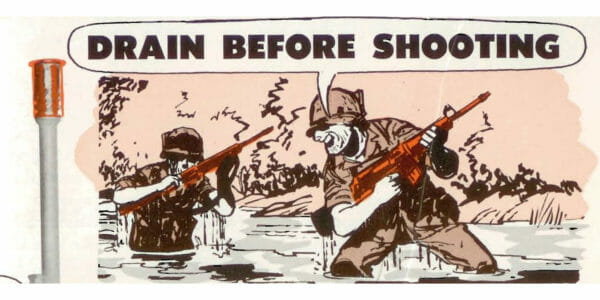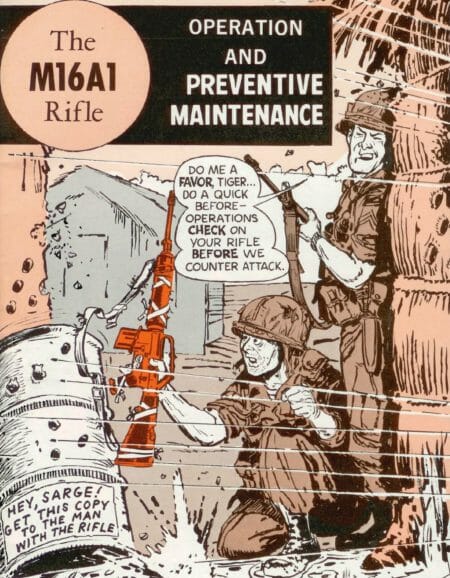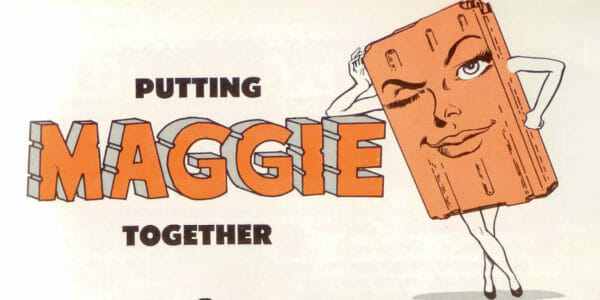
U.S.A. – -(AmmoLand.com)- Despite early interest from the Air Force, the M16 did not get off to a good start with the US military as a whole. In fact, Congress actually called members of the Air Force before them to testify and defend the rifle against a less-than-flattering article written about the rifle in the May 1962 issue of American Rifleman magazine.
Issues with cyclic rate, buffer tubes, lack of chrome-plating, changes in rifling twist, use of the wrong powder in cartridges, and a failure to properly train soldiers were just some of the most glaring issues that led to the rifle being viewed as questionable at best.
On June 1, 1968, a 200+ page document entitled, “REPORT OF THE M16 RIFLE REVIEW PANEL” was published and distributed to more than two dozen government and military officials. Based on more than 3,500 pages of research and reference material, the report was the result of a Congressional inquiry into the effectiveness of the M16 that began the previous year, in the spring of 1967.

Once the issues with the rifles themselves, as outlined above, had been worked out, there were still problems. Training, or the lack thereof, proved to be the biggest issue.
The 1968 report broke down training into four specific time frames. Phase I was November 1963 – February 1965; Phase II was March 1965 – December 1965; Phase III was December 1965 – December 1966; and Phase IV was December 1966 – February 1968.
During Phase I, training on the new rifles was a unit responsibility and was not standardized, nor was replacement training provided. In Phase II, replacement training began, but only on a limited scale.
Phase III saw the establishment of a standard training program that was eight hours in length. The program began implementation but was only available to soldiers with certain responsibilities, and shortages in both ammunition and blank-firing adapters hindered the progress.
When an inquiry into whether or not training should be expanded to all soldiers headed for Vietnam, it was determined that this was not feasible because rifles needed for training would be diverted from rifles that were supposed to head to Vietnam. It wasn’t until the final month of Phase III that every soldier would receive an M16 and go through the standard training program.
By April 1967, during Phase IV, the implementation of “one rifle, one soldier” was finally complete, but it was not without issue. Administrative issues allowed some soldiers to slip through the cracks; other times, entire units received their rifles just 10 days before deployment.

An in-country survey of the M16 from 1966 observed problems with the rifles and reported that malfunctions were primarily due to “inadequate cleaning, improper lubrication, and the continued use of worn parts.”
The most common faults observed were excessive oil on the weapon; carbon buildup in the chamber, bolt, and bolt carrier group; overloading of magazines; oil and grit inside magazines (frequently accompanied by lubricated ammunition); and failure to replace worn or broken extractors and extractor springs.
In short, much of the malfunctions observed in Vietnam were due to a lack of education surrounding the new rifles. This was supported by further findings that reported “shortages of technical manuals, cleaning equipment, and repair parts, and a general lack of knowledge of the M16 among officers and noncommissioned officers.”
In order to combat this lack of knowledge, the military released a detailed manual outlining what to do and what not to do in order to keep the M16 running properly. The 29-page operation and maintenance manual was completed and issued in the form of a comic book, presumably to make sure it got read and not just discarded like most standard, dry military manuals. It has been adapted and updated over the years, but the gist of it has remained the same.
It’s a pretty neat document from a historical perspective. The illustrations in this article are all excerpts from the manual, and you can still pick them up fairly cheap on eBay.
U.S. Army M16 Rifle Operation and Maintenance Manual
Check out Brownells Retro Rifles for reproductions of the rifle carried by U.S. soldiers in Vietnam here.

About Logan Metesh
Logan Metesh is a historian with a focus on firearms history and development. He runs High Caliber History LLC and has more than a decade of experience working for the Smithsonian Institution, the National Park Service, and the NRA Museums. His ability to present history and research in an engaging manner has made him a sought after consultant, writer, and museum professional. The ease with which he can recall obscure historical facts and figures makes him very good at Jeopardy!, but exceptionally bad at geometry.


Many soldiers were draftees and often barely high school graduates. Shooting and jungle warfare were not their goal in life. Just surviving until discharge was often the goal. Apathy was a big problem that contributed to low moral and often poor combat results. Cleaning kits were generally not issued. A production change of powder from IMR granular extruded powder to spherical powder that was faster to manufacture but dirtier. Ball ammo was 55 grains and a twit rte of 1-12 inch which was perfect for a sporting varmint rifle firing 45-52 grain bullets from a 24 inch barre. The M16… Read more »
I have a copy of that manual and it is an excellent teaching device, still. The history of the M16 is interesting and even today, the M16 is still undergoing changes; some good, some not so good. Ironically, it takes combat to “work out the bugs” on any weapon system, even in the M16 as we found out with the ammo in Vietnam and also with the ammo in the M-4 in Kuwait & Iraq.
I miss Connie…..
I remember watching a documentary on the M16 quite a few years ago, from what I remember it was almost scrapped due to the amount of issues the soldiers were having with it in the field.
Preventive Maintenance Monthly. Who doesn’t remember that! They are a big item at gun shows, now. I wish, I had a nickel for every one that I threw away.
When I went trough Basic Training at Fort Ord in Jan. 1963 they did not have enough M-14’s for us to use. So we had a 2 hour class on the M-14. We had to use the M-1 for Basic training.
Same old story as the M-16,
We were told they did not have enough M-14’s for the line outfits yet. So we had to use the M-1 for basis training.
The best part is that the Army is still making PS Magazine. They don’t do print subscriptions anymore, but there are other resources: https://www.logsa.army.mil/#/psmag
There’s an archive on that page that you can search or read by year. Well worth a look!
What I really don’t get is enthusiasm for the A1 model. Must be purely nostalgia.
Same as the enthusiasm for the A2 model. The full size rifles with full furniture tend to balance better, tend to be more accurate than an off the shelf similarly configured M4 style, have a softer recoil impulse, and since they are now the exception instead of the Rule having one just makes you feel a little more unique. Kind of like having an AR10 with a inside the carry handle bolt charger. Plus, when you understand the sighting setup, its pretty cool to most guys bragging about shooting out to 500 yards with a scoped 308 to be able… Read more »
Reprinted by Skyhorse Publishing $12.95 – https://www.skyhorsepublishing.com/9781616088644/the-m16a1-rifle/
I have a book that tells the history of Will Eisner’s pet project with all sorts of manuals while he was in the Army. He’s the same guy who did The Spirit, and his manuals were very popular. The whole PS Magazine series is fantastic, if only for the art. But some of the information, such as preventative maintenance of vehicles, and how to load a truck, still can apply today. Here’s a link to the book I got.
https://www.amazon.com/gp/product/0810997487